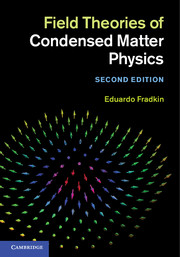Book contents
- Frontmatter
- Contents
- Preface to the second edition
- Preface to the first edition
- 1 Introduction
- 2 The Hubbard model
- 3 The magnetic instability of the Fermi system
- 4 The renormalization group and scaling
- 5 One-dimensional quantum antiferromagnets
- 6 The Luttinger liquid
- 7 Sigma models and topological terms
- 8 Spin-liquid states
- 9 Gauge theory, dimer models, and topological phases
- 10 Chiral spin states and anyons
- 11 Anyon superconductivity
- 12 Topology and the quantum Hall effect
- 13 The fractional quantum Hall effect
- 14 Topological fluids
- 15 Physics at the edge
- 16 Topological insulators
- 17 Quantum entanglement
- References
- Index
17 - Quantum entanglement
Published online by Cambridge University Press: 05 March 2013
- Frontmatter
- Contents
- Preface to the second edition
- Preface to the first edition
- 1 Introduction
- 2 The Hubbard model
- 3 The magnetic instability of the Fermi system
- 4 The renormalization group and scaling
- 5 One-dimensional quantum antiferromagnets
- 6 The Luttinger liquid
- 7 Sigma models and topological terms
- 8 Spin-liquid states
- 9 Gauge theory, dimer models, and topological phases
- 10 Chiral spin states and anyons
- 11 Anyon superconductivity
- 12 Topology and the quantum Hall effect
- 13 The fractional quantum Hall effect
- 14 Topological fluids
- 15 Physics at the edge
- 16 Topological insulators
- 17 Quantum entanglement
- References
- Index
Summary
Classical and quantum criticality
In most cases the phases of quantum field theories, in particular those of interest in condensed matter physics, can be described in terms of the behavior of local observables, such as order parameters or currents that transform properly under the symmetries of the theory. Quantum and thermal phase transitions are characterized by the behavior of these observables as a function of temperature and of the coupling constants of the theory. The phase transitions themselves, quantum or thermal, are classified into universality classes, which are represented by the critical exponents which specify the scaling laws of the expectation values of the observables. Historically, the development of this approach to critical behavior goes back to the Landau theory of critical behavior. It acquired its most complete form with the development of the renormalization group (RG) in the late 1960s and early 1970s. It is the centerpiece of Wilson’s approach to quantum field theory, in which all local quantum field theories are defined by the scaling regime of a physical system near a continuous phase transition. From this point of view there is no fundamental difference between classical (or thermal) phase transitions, which are described by the theory of classical critical behavior, and quantum phase transitions.
For example, the expectation value of a local order parameter M as the thermal phase transition is approached from below behaves as M ~ (Tc − T)β. Here Tc is the critical temperature and β is a critical exponent that depends on the universality class of the thermal phase transition and on the dimensionality of space. While quantum mechanics can play a key role in the existence of the ordered phase, e.g. superfluidity and superconductivity are macroscopic manifestations of essentially quantum-mechanical phenomena, the thermal transition itself is governed entirely by classical statistical mechanics, and quantum mechanics plays a role in setting the value of non-universal quantities such as the critical temperature, etc. On the other hand, in the case of a quantum phase transition, the order parameter M has a similar scaling behavior as a function of the coupling constant, M~(gc−g)β˜, where g is the coupling constant, gc is the critical coupling constant, and β˜ is a critical exponent that depends on the universality class of the quantum phase transition. Here we assume that M has a non-vanishing expectation value only for g < gc.
- Type
- Chapter
- Information
- Field Theories of Condensed Matter Physics , pp. 753 - 798Publisher: Cambridge University PressPrint publication year: 2013



